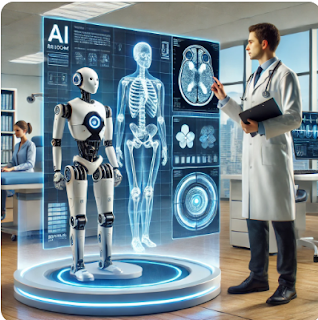How Artificial Intelligence is Revolutionizing Healthcare: A Comprehensive Guide with Tips and Examples
 |
| The role of artificial intelligence in analyzing medical examinations. Now I will create the second image that expresses how artificial intelligence helps in providing personalized care. |
Introduction
The healthcare industry is undergoing a seismic shift thanks to Artificial Intelligence (AI). From accelerating drug discovery to personalizing patient care, AI is transforming how we diagnose, treat, and manage diseases. With projections estimating that the global AI healthcare market will reach $31.3 billion by 2025, its impact is both profound and far-reaching. This comprehensive guide explores groundbreaking AI applications in healthcare, provides actionable tips and real-world examples, and offers practical guidelines to help you harness AI’s full potential. Whether you’re a healthcare provider, patient, or technology enthusiast, read on to discover how AI is reshaping the future of medicine.
1. AI Applications in Healthcare: Tips, Examples, and Guidelines
 |
| How AI is helping to provide personalized patient care through a virtual assistant. You can use these images to support your article and make it more visually appealing 2 |
Tip 1: Use AI for Faster, More Accurate Diagnoses
AI-powered tools can analyze medical images and data at speeds far exceeding human capabilities, reducing diagnostic errors and expediting treatment decisions.
- Example: Google’s DeepMind has demonstrated the ability to detect over 50 eye diseases from retinal scans with an impressive 94% accuracy.
- Guideline: Hospitals and clinics can integrate platforms like IBM Watson Health to analyze CT scans, MRIs, or X-rays. Begin with pilot programs in specific departments, such as radiology, to measure improvements in diagnostic accuracy and workflow efficiency.
Tip 2: Streamline Drug Development
AI significantly reduces the time and cost associated with discovering new drugs, accelerating the journey from laboratory research to patient treatment.
- Example: Insilico Medicine leveraged AI to identify a promising fibrosis treatment candidate in just 46 days.
- Guideline: Pharmaceutical companies should consider partnerships with AI startups like Atomwise for virtual drug screening and early-stage compound identification. This collaboration can lead to a more agile drug development process.
Tip 3: Automate Administrative Tasks
Administrative burdens can detract from patient care. AI-driven automation can handle routine tasks, freeing up healthcare staff for more critical responsibilities.
- Example: Olive AI automates prior authorization processes, saving hospitals over 50 hours per week.
- Guideline: Implement AI chatbots such as Sensely to manage patient inquiries, appointment bookings, and even preliminary symptom assessments, thereby streamlining administrative workflows.
Tip 4: Predict and Manage Chronic Diseases
Predictive analytics powered by AI can foresee complications in chronic conditions, enabling preemptive care and personalized treatment plans.
- Example: Dexcom’s advanced glucose monitoring systems use AI algorithms to alert diabetics when blood sugar levels reach dangerous thresholds.
- Guideline: Utilize platforms like KenSci to analyze patient data continuously and create individualized risk profiles, helping clinicians develop proactive management strategies for chronic illnesses.
2. AI and Personalized Medicine: A Step-by-Step Guide
Personalized medicine tailors treatments to individual patient profiles, and AI plays a crucial role in making this possible. Here’s a step-by-step guide:
Step 1: Collect Comprehensive Patient Data
Begin by gathering extensive data, including genomic information, lifestyle factors, and complete medical histories.
- Tool Spotlight: Tempus employs AI to analyze both clinical and molecular data, which is particularly useful for crafting personalized cancer treatment plans.
Step 2: Analyze Data with Machine Learning
Utilize machine learning algorithms to detect patterns and predict individual treatment responses.
- Example: PathAI assists pathologists by analyzing biopsy samples, leading to more precise cancer diagnoses.
Image Insight: Visualize how AI-powered virtual assistants help provide personalized patient care. Use supporting images to enhance understanding of these advanced diagnostic tools.
Step 3: Deliver Tailored Therapies
Leverage AI-driven insights to develop customized treatment regimens that address the unique needs of each patient.
- Case Study: Boston Children’s Hospital uses AI to design individualized seizure treatments for epilepsy patients, optimizing care and improving outcomes.
3. Overcoming Challenges: Ethical and Practical Solutions
While AI offers immense benefits, several challenges must be addressed to ensure its ethical and effective implementation in healthcare.
Challenge 1: Data Privacy Risks
Handling sensitive patient data necessitates stringent security measures.
- Solution: Adopt HIPAA-compliant platforms, such as Microsoft Azure, for secure data storage and transmission. Encrypt data rigorously and conduct regular security audits to safeguard patient information.
Challenge 2: Algorithmic Bias
AI systems can inadvertently perpetuate biases if trained on non-diverse datasets.
- Solution: Ensure that AI models are trained on multi-ethnic, diverse datasets. For example, IBM Watson Health incorporates a broad range of demographic data to reduce bias and improve diagnostic accuracy.
Challenge 3: Regulatory Compliance
Navigating the evolving regulatory landscape can be complex.
- Guideline: Stay informed about FDA guidelines for AI/ML-based Software as a Medical Device (SaMD) and collaborate with legal experts to ensure compliance with regional and international laws.
4. The Future of AI in Healthcare: Trends to Watch
As AI continues to evolve, several emerging trends promise to further transform healthcare delivery:
- Telehealth 2.0: AI-powered wearables, such as the Apple Watch ECG, will facilitate real-time remote monitoring, allowing for more proactive patient care.
- Preventive Care: Innovations like Fitbit’s AI-driven insights can predict heart issues before symptoms manifest, leading to earlier interventions.
- Robot-Assisted Surgery: Systems like the da Vinci Surgical System are already performing minimally invasive surgeries with enhanced precision, reducing recovery times and improving outcomes.
Actionable Tip: Invest in continuous staff training programs to bridge the AI skills gap. Online platforms like Coursera offer specialized certifications in healthcare AI, ensuring that your team remains at the forefront of technological advancements.
5. Frequently Asked Questions (FAQ)
Conclusion
Artificial Intelligence is reshaping the healthcare landscape by enhancing diagnostic accuracy, streamlining operations, and enabling personalized patient care. While the journey toward full integration is filled with challenges—ranging from data privacy to regulatory compliance—the potential benefits far outweigh the hurdles. By following the tips, guidelines, and examples outlined in this guide, healthcare providers and institutions can effectively harness AI’s transformative power to deliver better patient outcomes and drive innovation. Embrace AI today and join the revolution toward a healthier, smarter tomorrow.
SEO Keywords: AI in healthcare, medical AI applications, AI diagnosis, personalized medicine AI, healthcare AI challenges, future of AI in medicine
By providing in-depth insights, practical advice, and real-world examples, this guide is designed to engage readers and rank highly on search engines. Stay informed, adopt best practices, and leverage AI .to transform healthcare for the better.




